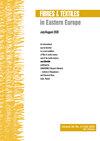Effect of Pumice Powder on Mechanical, Thermal, and Water Absorption Properties of Fiberboard Composites
IF 0.9
4区 工程技术
Q3 MATERIALS SCIENCE, TEXTILES
引用次数: 0
Abstract
Abstract Composites were produced using medium-density fiberboard (MDF) flour with pumice powder which was mixed at various ratios by the hand lay-up technique. Mechanical properties, such as tensile and three-point bending strengths, were determined by ASTM D3039 and ASTM D790 respectively. The best three-point bending and tensile strength properties were maximum values obtained from composites containing 20wt% pumice powder (pp) and 50wt% pumice powder (pp) respectively. It is observed that the water absorption rate into the composites decreases with an increase in the pumice powder-to-ratio. The composite filled with 50wt%pumice powder absorbed the least amount of water compared to the other composites. All composites were characterized by scanning electron microscopy (SEM), Fourier transforms infrared spectroscopy (FTIR), and differential scanning calorimetry analysis (DSC). SEM images revealed a near-homogeneous surface partly free of defects and holes. However, lateral profile images showed the presence of MDF flour particles agglomerated and a considerable number of bubbles and cavities that could interfere with the mechanical properties of the composites. The results of the mechanical, and thermal properties suggested that pumice powder epoxy composites with MDF flour can increase their tensile, three-point-bending strength, and glass transition temperature for the pure MDF flour composite.浮石粉对纤维板复合材料力学、热、吸水性能的影响
摘要用中密度纤维板(MDF)粉与浮石粉以不同比例混合,采用手工叠层技术制备了复合材料。机械性能,如拉伸强度和三点弯曲强度,分别通过ASTM D3039和ASTM D790测定。最佳的三点弯曲强度和拉伸强度分别是由含有20wt%浮石粉末(pp)和50wt%浮石粉(pp)的复合材料获得的最大值。观察到,随着浮石粉体比例的增加,复合材料的吸水率降低。与其他复合材料相比,填充有50wt%浮石粉末的复合材料吸收的水最少。通过扫描电子显微镜(SEM)、傅立叶变换红外光谱(FTIR)和差示扫描量热分析(DSC)对所有复合材料进行了表征。SEM图像显示了部分没有缺陷和孔的近乎均匀的表面。然而,横向剖面图像显示,中密度纤维板面粉颗粒团聚,存在大量气泡和空腔,这些气泡和空腔可能会干扰复合材料的机械性能。力学性能和热性能的结果表明,浮石粉-环氧树脂与中密度纤维板粉复合材料可以提高纯中密度纤维面板粉复合材料的拉伸强度、三点弯曲强度和玻璃化转变温度。
本文章由计算机程序翻译,如有差异,请以英文原文为准。
求助全文
约1分钟内获得全文
求助全文
来源期刊

Fibres & Textiles in Eastern Europe
工程技术-材料科学:纺织
CiteScore
1.60
自引率
11.10%
发文量
12
审稿时长
13.5 months
期刊介绍:
FIBRES & TEXTILES in Eastern Europe is a peer reviewed bimonthly scientific journal devoted to current problems of fibre, textile and fibrous products’ science as well as general economic problems of textile industry worldwide. The content of the journal is available online as free open access.
FIBRES & TEXTILES in Eastern Europe constitutes a forum for the exchange of information and the establishment of mutual contact for cooperation between scientific centres, as well as between science and industry.
 求助内容:
求助内容: 应助结果提醒方式:
应助结果提醒方式:


